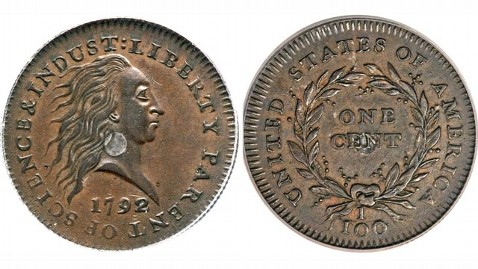I'm not as familiar with paper money as with numismatics. Fascinating area of study if you ever wanted to get into it. The U.S. Mint was authorized by Congress on on April 2, 1792. Many members of the House wanted to depict George Washington on the first U.S. coins. But the president rejected the idea as too monarchical. As a result, an image of the goddess Liberty was chosen instead.

Liberty was on most American coinage throughout the 19th century, one exception being the introduction of the Indian Head cent.

Presidents didn't start appearing on coinage until the 20th century, the first being Abraham Lincoln in 1909. The original design was done by engraver Victor David Brenner.
Interesting controversy about the first Lincoln pennies. It was normal at the time for U.S. coins to be inscribed with the designer's single initial, usually at the base of Liberty's neck. But Charles Barber, still chief engraver at the mint, did not wish the public to think that he, Barber, was responsible for the new design, so rather than a single B, all three of Brenner's initials V.D.B. were used and placed on the reverse. Upon the cent's release, journalists ignorant of the initials already on other U.S. coins, seized upon the V.D.B. as egotism on the designer's part. Combined with putting an actual person on a U.S. coin, the initials were regarded by some as "the first visible and outward emblem of the transmogrification of the republic into an empire" (New Orleans Picayune). The prominence of the V.D.B. was widely criticized in the media.

Secretary of the Treasury Franklin MacVeagh suspended striking of Lincoln cents on August 5, 1909, after about 29 million had been struck with V.D.B.. The intent was to replace the initials with an inconspicuously placed B, but Barber objected, arguing that it would take too long to change the dies. However, he suggested, if the initials were simply removed altogether, this change could be quickly done to just the hubs, and production could be resumed within three days. With all the publicity surrounding the new cents, the revenue that would be lost by the production delay if the dies were changed, and probably in some part considering Chief Engraver Barber's personal jealousies, it was decided to just remove the initials altogether. This change to the brand-new cents right after their release received plenty of publicity, and the hoarding of the V.D.B. cents became widespread. For this reason, many V.D.B.s have survived in higher grades.
In 1918, after Barber's death, V.D.B. was restored to the cent, this time on the obverse, and barely visible to the naked eye. Compare the old location to the new one here:

Victor David Brenner's design has stood the test of time, and his Lincoln bust is one of the most reproduced works of art in the world.